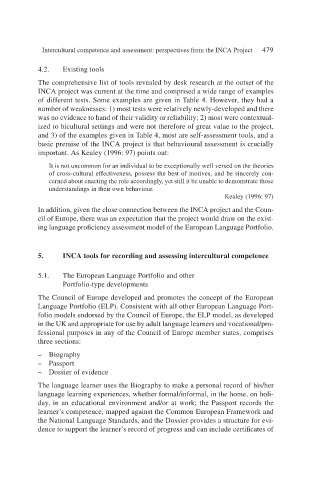Page 501 - Handbooks of Applied Linguistics Communication Competence Language and Communication Problems Practical Solutions
P. 501
Intercultural competence and assessment: perspectives from the INCA Project 479
4.2. Existing tools
The comprehensive list of tools revealed by desk research at the outset of the
INCA project was current at the time and comprised a wide range of examples
of different tests. Some examples are given in Table 4. However, they had a
number of weaknesses: 1) most tests were relatively newly-developed and there
was no evidence to hand of their validity or reliability; 2) most were contextual-
ized to bicultural settings and were not therefore of great value to the project,
and 3) of the examples given in Table 4, most are self-assessment tools, and a
basic premise of the INCA project is that behavioural assessment is crucially
important. As Kealey (1996: 97) points out:
It is not uncommon for an individual to be exceptionally well versed on the theories
of cross-cultural effectiveness, possess the best of motives, and be sincerely con-
cerned about enacting the role accordingly, yet still it be unable to demonstrate those
understandings in their own behaviour.
Kealey (1996: 97)
In addition, given the close connection between the INCA project and the Coun-
cil of Europe, there was an expectation that the project would draw on the exist-
ing language proficiency assessment model of the European Language Portfolio.
5. INCA tools for recording and assessing intercultural competence
5.1. The European Language Portfolio and other
Portfolio-type developments
The Council of Europe developed and promotes the concept of the European
Language Portfolio (ELP). Consistent with all other European Language Port-
folio models endorsed by the Council of Europe, the ELP model, as developed
in the UK and appropriate for use by adult language learners and vocational/pro-
fessional purposes in any of the Council of Europe member states, comprises
three sections:
– Biography
– Passport
– Dossier of evidence
The language learner uses the Biography to make a personal record of his/her
language learning experiences, whether formal/informal, in the home, on holi-
day, in an educational environment and/or at work; the Passport records the
learner’s competence, mapped against the Common European Framework and
the National Language Standards, and the Dossier provides a structure for evi-
dence to support the learner’s record of progress and can include certificates of

